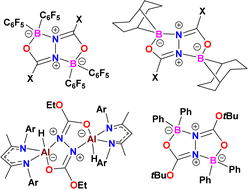Transient hydroboration and hydroalumination of activated azo-species: avenues to NBO and NAlO-heterobicycles†
Abstract
Reactions of the boranes, BH(C6F5)2 or 9-BBN, with azodicarboxylates or an azodicarbonylamide provide facile access to NBO heterocyclic compounds. The products [(C6F5)2BOC(X)N]2 X = OEt 1, OiPr 2, OCH2CCl33, OCH2Ph 4, NC5H105) and [(9-BBN)OC(X)N]2 (X = OEt 6, OiPr 7, NC5H108) and [Ph2B)OC(OtBu)N]29 were prepared. In another variation, (nacnac)AlH2 (nacnac = (C6H3iPr2NC(Me))2CH) afforded the Al-heterobicycle [(nacnac)Al(H)OC(OEt)N]210. The mechanism for the formation of these products is proposed to involve transient hydroboration or hydroalumination of the N![[double bond, length as m-dash]](https://www.rsc.org/images/entities/char_e001.gif) N double bond.
N double bond.



 Please wait while we load your content...
Please wait while we load your content...